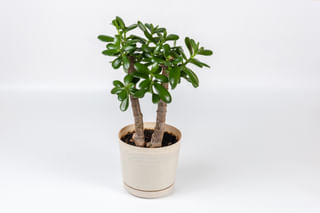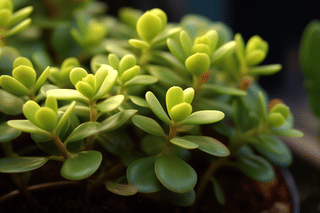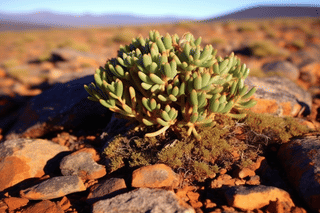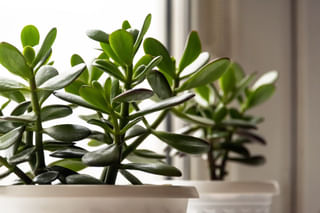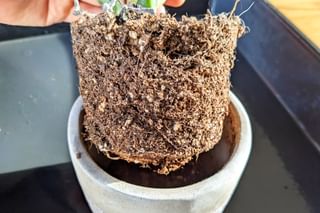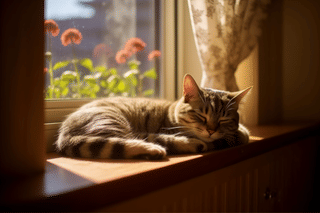How to take care of a Jade Plant
The Jade Plant is a succulent that looks a lot like a mini tree. It's a very beginner-friendly houseplant that loves the sun. In this plant care guide, we're going to discover at how you can best take care of your Jade Plant and how to help it thrive in your house.
The Jade plant is a tree-like succulent that makes a great addition to any bright space in your home. Like most other succulents, the Jade plant is a beginner-friendly plant that needs very little maintenance. It can grow quite large and live for a very long time when you're taking great care of it.
In this plant care guide, we're going to look at how you can give your Jade Plant the great care it needs to grow big and have a long life. As the Jade plant is a succulent plant, sunlight and water are 2 of the most important parts of its plant care routine. However, I'll also cover a few other topics in this plant care guide to set you up for success:
Let's give your Jade plant the best chances to grow big and strong by exploring everything there is to know about it. Let's get started!
Watering your Jade Plant
Watering your Jade Plant is the most important aspect of your plant care routine to get right. Luckily, watering a succulent, in general, is an easy task, because you can forget about it for a few weeks without any issues.
The Jade plant does prefer dry feet as well since it's very sensitive to overwatering: It gets root rot quite quickly. On the other hand, underwatering can lead to dehydration and wilting. Therefore, the key is to find the right balance and to water your Jade Plant only when it needs it.
If you know you're generally someone who loves to water your plants a lot, you might want to look at some more moisture-loving plants.
How often should you water a Jade plant?
Watering your Jade Plant is a very low-maintenance task because you won't have to water it very often, even in the spring and summer. Your Jade Plant loves to be in a very dry environment where it's dry for weeks at a time. However, don't let it dry out for too long, as it still needs moisture to support the weight of its stems. When the Jade plant grows larger and larger, you might have to water your plant a little more often to make sure it stays stable.
To know when your Jade Plant needs to be watered, you should check the soil. The soil should be completely dry before you water your plant again. A good way to check this is by sticking your finger into the soil up to the second knuckle. If the soil feels dry, it's time to water your Jade Plant. Remember, do not water if the soil still feels moist or damp, as Jade plants are very sensitive to overwatering.
As a general rule of thumb, water your Jade Plant once every 2-3 weeks during the growing season (spring and summer).
When you water your Jade Plant, it's ideal if you have a pot with a drainage hole in the bottom. This drainage hole helps to prevent overwatering your beautiful Jade plant. The excess water will drain out of the pot and only the moisture in the soil will stay in the pot.
Watering your Jade Plant in the winter
In the winter, when your Jade Plant goes dormant, you won't have to water your plant as often as you did in the spring and summer. When your Jade Plant is dormant, during the fall and winter, it won't grow (as quickly) and won't need as much water.
In the winter, your plant is dormant and is recovering from the growing season. On average, you should water your Jade Plant every 4-6 weeks in the winter. However, it's important to check on the soil regularly to get a more accurate watering schedule. The soil has to be completely dry before you water your plant again.
Can I use tap water for my Jade Plant?
Many plant owners wonder if you can use tap water for a Jade plant. As a rule of thumb, if you can safely drink your tap water, you can use it for your plant as well. However, it's important to keep in mind that it should be room temperature: not too hot or cold.
If your tap water has a lot of harsh chemicals in it, you can let the water sit for at least 24 hours to allow any chlorine or other chemicals to evaporate. After this, you can use it for your plants.
How do I know if my Jade Plant is getting too much or too little water?
An accident is easily made and perhaps you forgot to water your plant for a few weeks too many or you've watered your plant too much in the past few weeks. Your Jade plant might not be very happy at the moment, so how do you know if your Jade Plant is getting too much or too little water?
Check the soil
The soil in which your Jade Plant is growing can give you a lot of clues about water levels. If the soil feels dry and crumbly to the touch, it's time to water your plant. On the other hand, if the soil is waterlogged and constantly wet, your plant is getting too much water.
Look for signs of overwatering or underwatering
Overwatered Jade Plants may have yellow or brown leaves, with a mushy texture. Underwatered plants will show symptoms such as wrinkled or droopy leaves, or leaves that fall off easily.
How do I prevent overwatering my Jade Plant?
Jade Plants are tough and forgiving plants, but overwatering can be deadly for your Jade Plant. For new plant owners, it can be easy to overwater your houseplants. So how do you prevent overwatering?
The easiest way to prevent overwatering is by following a watering schedule by watering them when the top inch of soil is dry. Depending on your climate, water your Jade Plant once every 2 to 3 weeks or once a month.
To make your life a little easier, use well-draining soil made up of 50% potting soil, 25% perlite, and 25% coarse sand to help any excess moisture drain to the bottom of the pot quickly. Always use a lot with a drainage hole to remove this excess water from the pot.
If you regularly check the soil moisture and use a pot with a drainage hole, it'll become very easy to properly water your plant over time.
Sunlight requirements for your Jade Plant

Now you know how to water your Jade plant properly, let's look at the best type of sunlight for your plant. The perfect amount of sunlight for your Jade Plant helps your plant to become happier, healthier, and above all: help it grow big.
Your Jade Plant is a plant that loves to be in a spot with a lot of direct sunlight. Your Jade Plant loves the direct sunlight and won't get sunburns from this exposure.
If you see your plant reaching for the light (becoming leggy), by leaning to one side or growing longer stems, your Jade plant isn't getting enough sunlight. If it's already in the brightest spot in your house, a simple solution is to rotate your plant by 90 degrees every week. This way it gets equal sunlight exposure on all sides and it'll grow straight up.
If you have a very young plant, it's best to place it in bright-indirect sunlight. The younger leaves are still quite sensitive and will burn easily. The older plants can stand in direct sunlight for hours every day without any problems.
You can read more about the type of sunlight each direction gives you in "Does the sunlight direction matter for your houseplant?".
Sunlight for your Jade Plant in the winter
During the winter, it can be difficult for Jade Plants to get their much-needed daily dose of sunlight, especially if they are indoors. So, it's important to place your Jade Plant in an area that receives bright, indirect sunlight for at least four hours per day. It's ideal to place your Jade Plant in the brightest spot in your home during winter, as the sun is lower and weaker this time of year.
If you notice your Jade Plant leaning towards the window, this is a sign that it needs more light. To prevent the plant from growing to one side, try rotating it every few days to make sure it's getting even sun exposure. It can also be a good idea to add extra light through growth lamps if your Jade Plant still isn't receiving enough sunlight exposure during the winter.
How do I know if my Jade Plant is getting enough sunlight?
Jade Plants are resilient succulents that can tolerate low light conditions, but they prefer a few hours of bright, indirect sunlight each day to stay healthy. If your Jade Plant is not getting enough sunlight, you may notice that its leaves are turning yellow, brown, or falling off.
To find out if your Jade Plant is getting enough sunlight, first, consider its location. If it is placed near a window or other source of natural light, it should be getting enough sunlight during the day. However, if it is located in a corner or further away from a window, you should think about moving it to a brighter spot.
Another way to check if your Jade Plant is receiving enough sunlight is to observe its growth. If you notice that your Jade Plant is growing slowly (slower than it has been), it may not be getting enough light. On the other hand, if it is growing rapidly and producing new leaves regularly, it's probably getting the right sunlight exposure.
Temperature requirements for your Jade Plant
If you're wondering what temperature is ideal for your Jade Plant, you've found the right section. These beautiful succulents are native to South Africa and thrive in warmer climates. While they can tolerate some temperature fluctuations, you should try to keep the temperature constant.
The ideal temperature for a Jade Plant is between 18 to 24 degrees Celsius (65 to 75 F) during the day and around 10 to 13 degrees Celcius (50 to 55 F) at night. This means that they thrive in a warm, sunny environment during the day and a cooler, darker environment at night.
Sudden temperature changes can stress your plant. Avoid placing it near extreme sources of heat or cold. Also, Jade Plants don't like drafty areas. Keep them in a consistent temperature zone for optimal growth.
Can I place my Jade Plant near an air conditioner or heating vent?
Jade Plants are tough and adaptable, able to handle various temperatures. But, remember to keep your plant away from direct contact with air blowing from the unit or vent. Sudden blasts of hot or cold air can harm the leaves and growth.
Instead, it is best to keep your Jade Plant at least a few feet away from the air conditioner or heating vent. This distance will provide enough space for your plant to receive indirect or ambient air circulation, which helps in the regulation of temperature and humidity levels around the plant.
Can I keep my Jade Plant outside during the summer?
During summer, you can keep your Jade Plant outside. It's easy to care for and can tolerate different temperatures and light levels. But remember, if it's consistently colder than 18 degrees Celsius (65 F) it may not thrive outdoors and you might want to move the plant back indoors.
Ensure your Jade Plant gets the right amount of sunlight daily. It prefers bright light, so placing it in a spot with full sun is best. But keep in mind, that this is only for older plants. Young Jade Plants can get damaged if exposed to too much direct sunlight. A spot in the partial shade is better for these younger plants.
Humidity requirements for your Jade Plant
Jade Plants thrive in warm and dry environments. They are used to the dry climate of their native regions and are used to storing water in their leaves, stems, and roots. So, it is important not to provide too much moisture to the plant, as this can rot the roots and cause permanent damage.
Ideally, the humidity levels for a Jade Plant should be between 40 to 50%. You can easily measure the humidity level of the plant's surroundings with a hygrometer. If the humidity level in your home is generally low, you won't have to make the air more humid, but you might have to water your plant a little more often as the moisture in the soil will evaporate more quickly.
Can I mist a Jade Plant to increase humidity?
Jade plants thrive in low humidity levels. As succulents, jade plants store water in their leaves, stems, and roots, enabling them to survive in environments with low humidity. Because of this, you won't need to mist your Jade plant to increase the humidity. The plant loves the drought.
The perfect soil for your Jade Plant
If you remember, in the section about watering your Jade Plant, I quickly mentioned the perfect soil for your plant. In this section, we're going to explore what the perfect soil for your Jade plant is and why it works so well for it.
You've already discovered that your Jade Plant thrives in a dry environment, so we'll need soil that dries out completely in a day or two. Pre-mixed succulent/cactus soil is great for this purpose. This soil mix contains a mix of potting soil, perlite, and coarse sand. Good proportions that work for my jade plant are 1/2 potting soil, 1/4 perlite, and 1/4 coarse sand.
Soil that contains perlite and coarse sand will let the moisture escape to the bottom of the pot quickly. This type of soil doesn't hold onto a lot of moisture, which is perfect for plants that love dry environments. Quickly draining soil like this prevents overwatering and keeps your Jade Plant in optimal health.
This soil mixture is also quite nutrient-poor, which is very similar to the natural habitats of most succulents and cacti. Let's look a little more into nutrients and fertilizer in the next section.
Fertilizing your Jade Plant
A Jade Plant, like many other succulents and cacti, doesn't need to be fertilized a lot. It doesn't grow very quickly, so you won't have to fertilize it every month, but it does need a little bit of fertilizer to grow.
You can help your Jade Plant thrive by fertilizing it twice per year: once at the beginning of spring and once at the beginning of the summer. When you do fertilize your Jade Plant, make sure to use liquid fertilizer and dilute it with water, otherwise, it'll be too concentrated for your plant.
You can read more about which fertilizer is best in "What is the best type of fertilizer for houseplants?".
Fertilizing your Jade Plant in the winter
In the winter, when your Jade Plant is dormant and it's not growing (as quickly), you shouldn't fertilize your houseplant at all. Your Jade Plant won't use the fertilizer and it'll stay behind in the pot. Over time, this will make the soil very salty and could kill your plant.
Can I use homemade compost as fertilizer for my Jade Plant?
Homemade compost is a natural and cost-effective way to provide your plant with the essential nutrients it needs to thrive. When it comes to Jade Plants, using compost as a fertilizer can help enhance growth, promote healthy foliage, and improve the plant's resistance to pests and diseases.
To use homemade compost as fertilizer for your Jade Plant, mix a small amount into the soil around the base of the plant. You can also add it as a top dressing, on the surface of the soil, and water it in.
By top-dressing the compost, you're not changing the well-draining properties of the soil, so this shouldn't become a risk for overwatering your Jade plant.
As compost is often a little less concentrated as a chemical fertilizer, you're running less risk of overfertilizing your plant, but it's still a good idea to start small and find the right amount of compost for your Jade plant.
Pruning your Jade Plant
Pruning your Jade Plant is crucial for its well-being and appearance. It promotes healthier and more balanced growth while removing damaged or diseased parts of the plant. Keep your plant in top shape through regular pruning.
Here are some helpful facts and tips for pruning your Jade Plant:
When to prune: Prune your Jade Plant in the spring or summer when it is actively growing. Avoid pruning during the fall or winter as this can cause stress on the plant and potentially harm it.
Where to cut: Look for stems or branches that are dead, damaged, or overgrown. Use clean, sharp pruning shears to cut the stem just above a leaf or node. Make sure to leave some "leaves" on the plant to help it continue to grow.
How much to prune: Only remove up to one-third of the plant at a time. Removing too much can cause shock to the plant and slow down its growth.
What to do with the cuttings: You can propagate your Jade Plant from cuttings! Simply let the cuttings dry out for a few days and plant them in potting soil. Keep the soil moist and in a warm, bright location until the cuttings take root.
Can I prune my Jade Plant to control its size?
To manage the size and maintain the health and beauty of your Jade Plant, pruning is a fantastic method. By cutting back specific branches or stems, you can encourage growth in desired areas and prevent overgrowth.
When it comes to pruning your Jade Plant, it's best to start by using clean and sharp pruning tools. Make sure that your blades are free of any dirt or debris to avoid any risk of infection or damage to the plant. Next, look at your plant carefully and identify any branches or stems that you want to remove. Focus on those branches that are growing too much or make the plant appear lopsided.
When you're ready to start pruning, take your time and work slowly and carefully. Begin by cutting the leaf stem close to the main stem of the plant. Make sure that you angle your cut in a way that promotes new growth. For larger branches, use a good pair of pruning scissors for the best results.
Propogating your Jade Plant
You can easily propagate your Jade Plant to expand your indoor garden. Simply take a cutting from your mature Jade Plant and nurture it into a new, independent plant. Follow the steps in this section to share this beautiful, resilient succulent with friends and family, or add more to your own home.
Here's how to do it:
- Start by choosing a healthy "parent" plant that has a few stems. The plant must be healthy and thriving, as this will increase the chances of successful propagation.
- Once you've chosen your parent plant, you can take a cutting. Use a clean, sharp knife or scissors to cut a stem that is at least 2 inches long. Make sure that the stem is healthy and has a few leaves on it.
- Once you've taken your cutting, allow it to dry out for a day or two. This will help to prevent the cutting from rotting when you plant it.
- After the cutting has dried out, it's time to plant it! You can either plant it directly in soil or water. If planting in soil, use a well-draining potting mix and make sure to water it lightly. If planting in water, place the cutting in a container of water and change the water every few days.
Be patient and wait for your new jade plant to grow! It can take several weeks or even months for roots to appear, but with proper care and patience, you should have a beautiful new jade plant in no time.
Repotting your Jade Plant
Repotting a Jade Plant is a relatively simple process. In this section, we're going to look at the steps to successfully repot your Jade plant.
When repotting your Jade Plant, start by choosing a bigger pot with good drainage. Make sure it's clean and debris-free. Then, prepare the soil by mixing equal parts of potting soil, perlite, and coarse sand.
Remove the Jade Plant from its pot by gently loosening the soil and pulling it up, being careful not to damage the roots. Inspect the roots for any signs of damage or disease. If you find any, trim them with clean scissors or shears.
First, add new soil mix to the bottom of the new pot, covering the drainage hole. Gently place the Jade Plant in the new pot and add more soil mixture around the roots, packing it down firmly. Thoroughly water the plant to ensure even moisture in the soil.
After repotting, your Jade Plant may need time to adjust to its new environment. Keep a close eye on the soil moisture levels and water accordingly to avoid over or underwatering.
How do I know a Jade plant should be repotted?
You may wonder if your Jade Plant can stay in a small pot or if it needs a larger one. Well, it actually depends on the size and age of your plant. Jade Plants like slightly shallow pots with good drainage, not cramped containers. They grow slowly, so repotting isn't needed often.
If your Jade Plant is outgrowing its pot, it's time to repot. Check the roots: if they're coming out of the drainage holes or tangled inside the pot, it's time to repot. Choose a slightly bigger pot to allow for growth. Avoid small pots that limit the plant's growth. Repot in spring or summer for the best results.
Jade Plants can stay in small pots for a while, but they will eventually need to be repotted into slightly larger ones. Remember to choose a pot with a drainage hole, inspect the roots from time to time, and transfer your plant to a bigger pot when it seems to be outgrowing the current one.
How long does it take for a Jade Plant to start growing new leaves?
Jade plants are slow-growing plants. It can take up to several months for a Jade Plant to start growing new leaves. However, with proper care and attention, you can encourage your plant to grow new leaves more quickly.
Here are some tips on how to make your jade plant grow new leaves:
Provide enough light: Jade Plants thrive in bright, direct sunlight. Make sure to place your plant near a window where it receives the ideal amount of sunlight. If you are growing your Jade Plant indoors, you can use artificial light to supplement its natural light source.
Water correctly: Overwatering can cause Jade Plants to rot, so it's important to water them correctly. Wait for the soil to dry out completely before watering your plant again. Also, make sure to use well-draining soil and a container with a drainage hole to avoid water retention.
Use fertilizer: Jade Plants benefit from regular fertilization. You can use a balanced fertilizer, such as 10-10-10, twice during the growing season (once in spring and once in summer). Avoid fertilizing your plant during the dormant season (fall and winter).
Your Jade plant won't quickly grow new leaves like some other plants, but by taking these steps, you'll see new growth faster than if you do nothing.
How big can a fully grown Jade Plant get?
When it comes to its size, the Jade Plant can reach up to 90 cm (3 ft) in height and width if you take great care of it and pay close attention to what it needs. This includes plenty of sunlight, watering when the plant is dry, fertilizing it twice per year, and a nice and consistent growing environment.
Is your Jade Plant toxic for pets?
Some plants are toxic for your pets and children and should be kept out of reach. You're probably asking yourself if your Jade Plant is toxic to your pets and small children.
Your Jade Plant is unfortunately toxic to pets and small children, so you should keep your Jade Plant away from them. The Jade Plant is highly toxic to pets as this plant's sap contains rubber. If your pet accidentally eats your plant, it can cause vomiting, depression, and heart problems. It's also mildly toxic for people and can cause vomiting and diarrhea.
So if you have pets or small children, you'll need to keep this plant out of place and keep an eye out for these symptoms. If you notice your pets have eaten this plant, call your veterinarian right away to prevent further harm.
What are common pests that can affect a Jade Plant?
Jade Plants are loved for their green leaves and resilience. But, like other plants, they can be harmed by pests. Knowing which pests to watch for helps keep your Jade Plant healthy.
Mealybugs are a common problem for Jade Plants. They feed on the sap, leading to yellowing and wilting. Keep an eye out for small white blobs on leaves or in crevices. You can control them by using a solution of rubbing alcohol and water or neem oil.
Spider mites are another common pest that can harm your Jade Plant. They are tiny and hard to see, but their presence is revealed by webbing on the leaves. These pests feed on plant sap, causing yellowing, browning, and leaf drop. If left untreated, they can severely damage and even kill your plant. Keep the leaves clean and spray a mix of water and soap to prevent them.
Scale insects are pests that can harm your Jade Plant. They look like small, brown bumps on the plant's leaves or stems and suck the sap, causing wilting and eventual death. You can eliminate these pests by hand or with a soft-bristled brush and soapy water.
Aphids can harm your Jade Plant. These small insects, green or black, feed on the plant's sap, causing yellowing and wilting. You can control them by releasing ladybugs onto your plant or using a mixture of water and dish soap.
Conclusion
In this plant care guide, we've looked at how you can take care of your Jade Plant. We've looked at how you can water your Jade Plant, the perfect sunlight exposure, the best soil, how to properly feed your Jade Plant, and whether it's toxic for your pets and kids.
The Jade plant is a gorgeous succulent that will do well in any bright place in your house. If you want a houseplant that has the potential to grow large and grow very old, the Jade Plant is the perfect plant for you.
Thank you for reading this post! I hope it helps you to keep your plants healthy and beautiful! If you're looking for more guides on specific plants, you can always request a plant guide to get a guide for the plant you have trouble with.
Test your plant care knowledge
Quiz completed!
Want to learn more? Sign up for my newsletter to receive free tips in your inbox!
Sign up now!